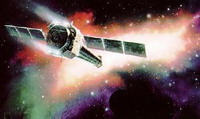NASA to disclose US aviation survey
NASA will reveal results of an unprecedented U.S. aviation survey that found that aircraft near collisions, runway interference and other safety problems occur far more often than previously recognized.

Provoking broad criticism, NASA had said previously it was withholding the information because it feared it would upset air travelers and hurt airline profits. NASA cited those reasons in refusing to turn over the survey data to The Associated Press, which sought the data over 14 months under U.S. freedom of information laws.
"I regret any impression that NASA was or would in any way try to put commercial interests ahead of public safety," NASA's administrator, Michael Griffin, testified during an oversight hearing. "That was not and never will be the case."
Democratic Rep. Bart Gordon, chairman of the House Science and Technology Committee, said NASA's reasons for withholding the research were "both troubling and unconvincing."
Griffin said he has directed release "as soon as possible" of all the research data that does not contain what he described as confidential commercial information. He said NASA spent $11.3 million (7.8 million EUR) on the research.
"The survey results we can legally release will be released, period," Griffin said.
It was unclear, however, how quickly NASA may release any of its research data. NASA said it will take time to perform its own analysis to ensure the numbers in its data are not misinterpreted, and it appeared unlikely the raw data would be released.
In an odd twist, Griffin raised doubts about the reliability of his own agency's research by telling lawmakers that NASA does not consider the survey's methodology or data to have been sufficiently verified.
Griffin confirmed NASA's research project showed many types of safety incidents occurring more frequently than were reported by other U.S. government monitoring programs. But he cautioned that the data was never validated and warned, "There may be reason to question the validity of the methodology," he said.
Experts who worked on the study say it adhered to the highest survey industry standards. The research was "state of the art," said Jon Krosnick, a Stanford University professor who helped create the survey questions. Disputing Griffin, Krosnick told Congress that aviation experts from NASA, the Federal Aviation Administration and other groups reviewed the research plans and said further scrutiny would not have been helpful.
"These peer review processes rarely yielded significant changes in the survey process," Krosnick said.
NASA's former head of the research project, Robert Dodd, told lawmakers the survey was based on "outstanding science," extensively tested and ready for meaningful analysis. Dodd said NASA's earlier explanations for withholding the information were "without merit."
"I don't believe that the ... data contained any information that could compare with the image of a crashed air carrier airplane or would increase passengers' fear of flying," Dodd said.
On Tuesday, Griffin bowed to a request from the lawmakers and sent copies to Capitol Hill of the raw data contained on four CDs.
Officials who have worked on the survey have said it contains no pilot names or airline names. The questionnaire asked pilots to state how many times in the previous 60 days they had encountered a wide range of problems with equipment, weather, tower communication and other safety issues.
NASA's efforts to withhold the safety research sparked tough criticism on Capitol Hill and in the editorial pages of dozens of leading newspapers - including USA Today, The New York Times and the Chicago Tribune - which urged the agency to release its research. The Times described NASA's reasons for withholding the information as "lame excuses."
Griffin also has sought to assure lawmakers that NASA will not destroy the research. Earlier this month, NASA ordered the contractor that conducted the survey to return any project information, then purge all related data from its computers. Griffin said he has rescinded those instructions.
Although to most people NASA is associated with spaceflight, the agency has a long history of aviation safety research. Its experts study atmospheric science and airplane materials and design, among other areas.
The survey project, called the National Aviation Operations Monitoring Service, was launched after a White House commission in the late 1990s called for government efforts to significantly reduce fatal aircraft accidents.
Subscribe to Pravda.Ru Telegram channel, Facebook, RSS!





